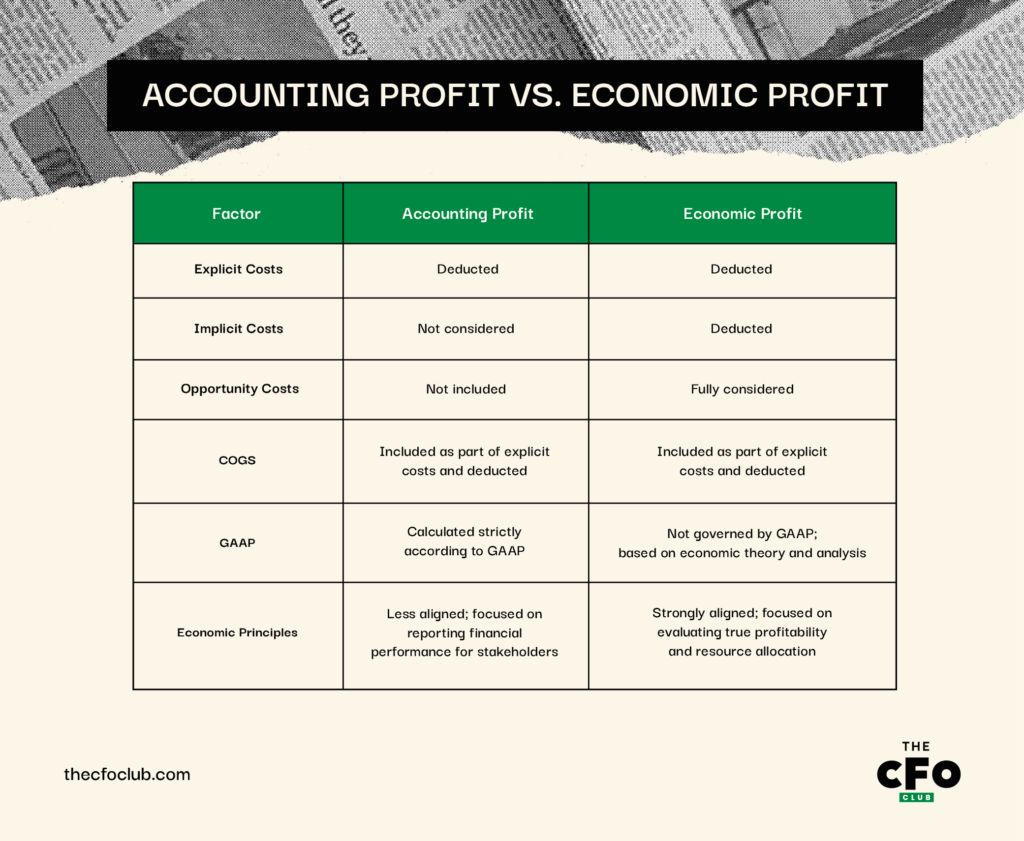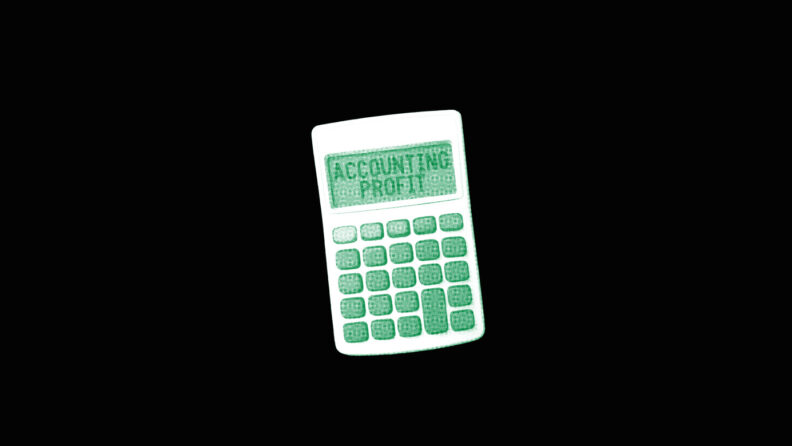Looking Past the Calculation: Accounting profit, beyond a simple calculation, influences strategic decisions, investor confidence, and financial health by accounting for operational expenses and depreciation.
Your Business, Your Frequency: How often you calculate accounting profit depends on how frequently you need insight into your business growth or profitability. This could be monthly, quarterly, or annually.
Accounting Profit vs. Other Profit Types: Accounting profit is very different from economic, taxable, and underlying profit. Economic profit includes both explicit and implicit costs, taxable profit uses taxable income defined by IRC, and underlying profit removes specific expenses to show core operating performance.
Calculating your accounting profit is straightforward: take your total revenue and subtract it from your total explicit costs. Simple enough, right?
While it may seem that way, for CFOs, accounting profit is more than a textbook calculation—it’s a key indicator that influences strategic decisions, investor confidence, and long-term financial health. It reflects not just revenues and direct costs, but the full weight of operational expenses, depreciation, and other accounting considerations.
As a former accountant, I understand how accounting profit can shape smart business decisions and reveal the true performance of a company. In this guide, I’ll break down the essentials: what accounting profit is, why it matters, and how you can calculate it accurately. Let’s get to the real numbers behind your business.
What Is Accounting Profit?
Accounting profit, also known as financial profit or bookkeeping profit, is a metric used to measure a company’s financial health. You can calculate it by subtracting all explicit costs from revenue, as recorded in your business’s financial statements.
Along with its definition, here are some other key facts about accounting profits that are valuable to know:
- It’s based on accrual accounting, not cash flow: For example, if you sign 200 annual SaaS subscriptions for $60,000 on December 30 (with a per-user service cost of $200), your year-end gross profit will show a $20,000 profit—even if the client hasn’t paid the invoice yet.
- It’s reported to stakeholders and investors: When looking at a company’s income statement or publicly reported earnings, you’re generally looking at accounting profit—the net profit on the income statement.
- It’s calculated net of non-cash expenses: U.S. Generally Accepted Accounting Principles (GAAP) require non-cash expenses like depreciation, amortization, and goodwill impairment to be recorded in the income statement. While you don’t pay cash every year for non-cash expenses, they’re not considered implicit costs, meaning they must be deducted to calculate accounting profit.
Why Is Accounting Profit Important?
Accounting profit is important for businesses because it provides a clear, standardized view of financial performance that is essential for both internal decision-making and external reporting.
For executives and CFOs, this metric helps guide budgeting, forecasting, and resource allocation by highlighting which areas of the business are profitable or underperforming. This allows finance leaders to make more informed decisions about where to invest, cut costs, or pursue growth.
How to Calculate Accounting Profit in 3 Steps
To calculate accounting profit, you’ll use the following formula:

Below, I’ve created a complete breakdown of what numbers you’ll need and how to find them:
1. Find the Total Revenue
Product sales or service rendering is typically the largest revenue stream for any business—you deliver a product or service, the customer pays (or commits to pay), end of story.
But there are other streams of revenue a business can have, such as:
- Subscription Revenue: If you offer subscriptions to your product, add-ons, or integrations, you receive monthly subscription revenue, which contributes to your topline.
- Licensing Revenue: Money received for letting another entity use your intellectual property, such as a company licensing a patent to another firm, is called licensing revenue.
- Franchise Revenue: Fees or royalties collected from franchisees are called franchise revenue. For example, McDonald’s receives money from franchise owners and earns franchise revenue.
- Rental or Leasing Income: If your company has leased commercial space or rents out equipment, you might see rental or leasing revenue and a detailed breakdown in the company’s notes to income statement.
- Commission Revenue: Commission revenue is generated when a company facilitates a sale between third parties. For example, if your product is a corporate travel management platform, you might earn commission revenue by allowing companies to book flights through your platform.
- Donations or Grants: Nonprofits may receive donations or grants from other entities. For example, a nonprofit educational platform might receive a grant for a specific purpose from another company or individual.
These are just some examples of types of revenue. There are various other types, but you get the gist. Our focus here is to determine the topline figure. Add all types of revenue, and that’s the total revenue figure you need to calculate accounting profit.
Remember: You can’t add advance payments to revenue. If you’re unsure what to include, always refer to the ASC 606, the accounting standard for revenue recognition.
2. Determine Explicit Costs
If a cost was paid out of the company’s pocket, it’s explicit. But in some cases, determining if a cost is explicit can be tricky.
For example, depreciation is a non-cash expense, which means you don’t shell out cash for it. However, cash was paid when you acquired the depreciated asset, so it’s not an implicit cost. You’re just spreading out that cost over the asset’s useful life after an initial cash outlay.
To quickly determine if a cost is explicit, consider the following framework: if it involves writing a check, swiping a card, or wiring money, either right now or at any point in the past or future, it’s probably an explicit cost.
Here are some examples of explicit costs you’ll likely encounter:
- Wages and salaries
- Rent
- Equipment and supplies
- Marketing and advertising
- Interest payments
- Insurance payments
- Transportation and shipping
- Licensing and permit fees
Once you know your explicit costs, calculating the total amount is fairly straightforward; however, you may encounter occasional caveats.
Sometimes, you’ll need to calculate your taxable income to compute your tax liability for the current year. Other times, you may have to make other complex calculations, such as goodwill impairment. After you figure out these nuances, add together your final numbers to get your total explicit costs.
3. Use the Accounting Profit Formula
Now, you’re ready for the finale. To calculate accounting profit, plug in the totals from the previous two steps into the formula listed above.
-

BlackLine
Visit WebsiteThis is an aggregated rating for this tool including ratings from Crozdesk users and ratings from other sites.4.5 -

Xledger
Visit WebsiteThis is an aggregated rating for this tool including ratings from Crozdesk users and ratings from other sites.4.5 -

FreshBooks
Visit WebsiteThis is an aggregated rating for this tool including ratings from Crozdesk users and ratings from other sites.4.5
Example of Calculating Accounting Profit
Suppose you work for a SaaS company. After calculating the total amounts for your monthly subscriptions and one-time onboarding and setup fees, you get the following total revenue cost:
| Revenue | Amount ($) |
| Monthly subscriptions | 1,200,000 |
| One-time onboarding and setup fees | 100,000 |
| Total Revenue | (1,300,000) |
After recording your total revenue, you'll then gather all of your explicit costs, including both operating and non-operating expenses. Here's a few examples of what you might include in your calculation:
| Explicit Costs: | Amount ($) |
| Developer salaries | 400,000 |
| Customer support team | 120,000 |
| Office rent | 60,000 |
| Cloud infrastructure (AWS) | 100,000 |
| Marketing costs | 90,000 |
| Software subscriptions | 30,000 |
| Depreciation on equipment | 20,000 |
| Insurance and licenses | 10,000 |
| Business travel | 10,000 |
| Miscellaneous | 10,000 |
| Taxes | 120,000 |
| Total explicit costs | (970,000) |
From there, you can input both numbers using the formula. With these amounts, you'd get the total for your accounting profit:
330,000 = 1,300,000 - 970,000
As you can see, calculating accounting profit itself is pretty simple. Where you might struggle is calculating explicit costs like depreciation and taxes, where you need to make additional computations.
When To Calculate Accounting Profit
Most companies calculate accounting profit monthly, quarterly, or annually because it’s a standard part of preparing the income statement at the end of each accounting cycle.
However, you can calculate accounting profit at any time of the year if you need insights for making decisions related to business expansion or profitability.
Calculate Accounting Profit With Software
In my experience, using software is non-negotiable for accounting processes, unless you want to spend days summing up every expense in your book and take on the risk of errors.
Modern accounting software integrates with various solutions, including your invoicing tool and CRM, and pulls data from them to automatically register revenue, expenses, and other transactions.
The result? You get a real-time view of accounting profit at all times. Whenever you want to look at your accounting profit, go to the income statement, and you’ll see it prepared for your chosen period.
If you’re currently searching for a reliable business accounting system, here are some of my top picks:
Accounting Profit vs. Economic Profit
The key difference between accounting profit and economic profit lies in the types of costs they consider.
- Accounting profit includes only explicit costs (i.e. actual out-of-pocket expenses, like salaries, rent, and materials)
- Economic profit includes both explicit and implicit costs, which include opportunity costs (i.e. forgone interest on funds invested in a business, depreciation of owned assets, etc.)
For example, if you spend your time running a business rather than taking the salary of a higher-paying job, you classify this as an implicit cost.
These costs aren’t recorded in accounting books and don’t impact accounting profit, but they are important from an economics perspective. Here are some other key differences between accounting and economic profits:

Accounting Profit vs. Taxable Profit
Unlike accounting profit, taxable profit is calculated using taxable income as defined by the IRC. It includes only those revenues and expenses that are recognized for tax purposes, and is used to determine tax liability.
Accounting Profit vs. Underlying Profit
Whereas accounting profit reflects the company’s official financial performance, underlying profit removes non-recurring, unusual, or non-operational items to show the recurring earnings from core operations.
It’s a non-GAAP measure that’s reported separately to give a clearer picture of core operating performance. To find it, you need to adjust the accounting profit by removing the impact of non-recurring or non-operational items.
For example: Say your business has an accounting profit of $1,400,000. Once you add back restructuring costs of $300,000 and subtract gain on asset sales of $200,000, you’ll receive an underlying profit of $1,500,000.
This number allows investors and CFOs to evaluate performance trends over time, as it provides a more stable basis for comparison and forecasting than raw accounting profit.
-

BlackLine
Visit WebsiteThis is an aggregated rating for this tool including ratings from Crozdesk users and ratings from other sites.4.5 -

Xledger
Visit WebsiteThis is an aggregated rating for this tool including ratings from Crozdesk users and ratings from other sites.4.5 -

FreshBooks
Visit WebsiteThis is an aggregated rating for this tool including ratings from Crozdesk users and ratings from other sites.4.5
Accounting Profit is a Starting Point
Calculating accounting profit is a good starting point, but to advance your career, you must be able to analyze the profit you calculate.
Look at the profit figure over time, compare it with peer companies, and investigate why it was higher or lower than in the previous accounting period.
Want to sharpen your accounting and finance skills? Subscribe to our free weekly newsletter for expert advice, guides, and insights from finance leaders shaping the tech industry.






